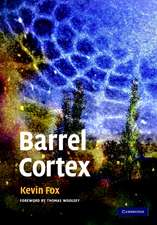Information Theory and the Brain
Editat de Roland Baddeley, Peter Hancock, Peter Földiáken Limba Engleză Paperback – 10 dec 2008
| Toate formatele și edițiile | Preț | Express |
|---|---|---|
| Paperback (1) | 351.74 lei 43-57 zile | |
| Cambridge University Press – 10 dec 2008 | 351.74 lei 43-57 zile | |
| Hardback (1) | 869.14 lei 43-57 zile | |
| Cambridge University Press – 14 mai 2000 | 869.14 lei 43-57 zile |
Preț: 351.74 lei
Nou
Puncte Express: 528
Preț estimativ în valută:
67.31€ • 70.45$ • 56.02£
67.31€ • 70.45$ • 56.02£
Carte tipărită la comandă
Livrare economică 31 martie-14 aprilie
Preluare comenzi: 021 569.72.76
Specificații
ISBN-13: 9780521087865
ISBN-10: 0521087864
Pagini: 360
Ilustrații: 123 b/w illus. 4 tables
Dimensiuni: 152 x 229 x 19 mm
Greutate: 0.48 kg
Editura: Cambridge University Press
Colecția Cambridge University Press
Locul publicării:New York, United States
ISBN-10: 0521087864
Pagini: 360
Ilustrații: 123 b/w illus. 4 tables
Dimensiuni: 152 x 229 x 19 mm
Greutate: 0.48 kg
Editura: Cambridge University Press
Colecția Cambridge University Press
Locul publicării:New York, United States
Cuprins
List of contributors; Preface; 1. Introductory information theory and the brain Roland Baddeley; Part I. Biological Networks: 2. Problems and solutions in early visual processing Brian G. Burton; 3. Coding efficiency and the metabolic cost of sensory and neural information Simon B. Laughlin, John C. Anderson, David O'Carroll and Rob de Ruyter van Stevenick; 4. Coding third-order image structure Mitchell Thomson; Part II. Information Theory and Artificial Networks: 5. Experiments with low entropy neural networks George Harpur and Richard Prager; 6. The emergence of dominance stripes and orientation maps in a network of firing neurons Stephen P. Luttrell; 7. Dynamic changes in receptive fields induced by cortical reorganization Germán Mato and Néstor Parga; 8. Time to learn about objects Guy Wallis; 9. Principles of cortical processing applied to and motivated by artificial object recognition Norbert Krüger, Michael Pötzsch and Gabriele Peters; 10. Performance measurement based on usable information Martin Elliffee; Part III. Information Theory and Psychology: 11. Modelling clarity change in spontaneous speech Matthew Aylett; 12. Free gifts from connectionist modelling John A. Bullinaria; 13. Information and resource allocation Janne Sinkkonen; Part IV. Formal Analysis: 14. Quantitative analysis of a Schaffer collateral model Simon Schultz, Stefano Panzeri, Edmund Rolls and Alessandro Treves; 15. A quantitative model of information processing in CA1 Carlo Fulvi Mari, Stefano Panzeri, Edmund Rolls and Alessandro Treves; 16. Stochastic resonance and bursting in a binary-threshold neuron with intrinsic noise Paul C. Bressloff and Peter Roper; 17. Information density and cortical magnification factors M. D. Plumbley; References; Index.
Recenzii
"...the skeptic as well as the aficionado of information theory will profit from reading this new book." The Quarterly Review of Biology
Descriere
This book deals with information theory, a new and expanding area of neuroscience which provides a framework for understanding neuronal processing.












